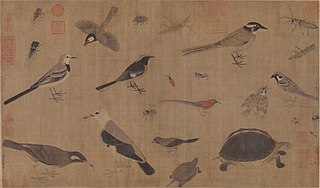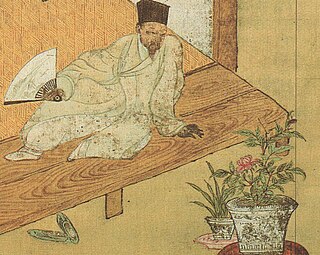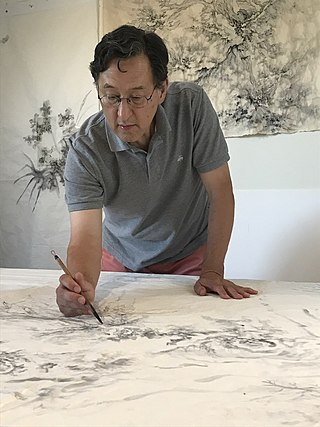
Chinese art is visual art that originated in or is practiced in China, Greater China or by Chinese artists. Art created by Chinese residing outside of China can also be considered a part of Chinese art when it is based on or draws on Chinese culture, heritage, and history. Early "Stone Age art" dates back to 10,000 BC, mostly consisting of simple pottery and sculptures. After that period, Chinese art, like Chinese history, was typically classified by the succession of ruling dynasties of Chinese emperors, most of which lasted several hundred years. The Palace Museum in Beijing and the National Palace Museum in Taipei contains extensive collections of Chinese art.

Ink wash painting ; is a type of Chinese ink brush painting which uses washes of black ink, such as that used in East Asian calligraphy, in different concentrations. It emerged during the Tang dynasty of China (618–907), and overturned earlier, more realistic techniques. It is typically monochrome, using only shades of black, with a great emphasis on virtuoso brushwork and conveying the perceived "spirit" or "essence" of a subject over direct imitation. Ink wash painting flourished from the Song dynasty in China (960–1279) onwards, as well as in Japan after it was introduced by Zen Buddhist monks in the 14th century. Some Western scholars divide Chinese painting into three periods: times of representation, times of expression, and historical Oriental art. Chinese scholars have their own views which may be different; they believe that contemporary Chinese ink wash paintings are the pluralistic continuation of multiple historical traditions.

Chinese painting is one of the oldest continuous artistic traditions in the world. Painting in the traditional style is known today in Chinese as guó huà, meaning "national painting" or "native painting", as opposed to Western styles of art which became popular in China in the 20th century. It is also called danqing. Traditional painting involves essentially the same techniques as calligraphy and is done with a brush dipped in black ink or coloured pigments; oils are not used. As with calligraphy, the most popular materials on which paintings are made are paper and silk. The finished work can be mounted on scrolls, such as hanging scrolls or handscrolls. Traditional painting can also be done on album sheets, walls, lacquerware, folding screens, and other media.

Chinese calligraphy is the writing of Chinese characters as an art form, combining purely visual art and interpretation of the literary meaning. This type of expression has been widely practiced in China and has been generally held in high esteem across East Asia. Calligraphy is considered one of the four most-sought skills and hobbies of ancient Chinese literati, along with playing stringed musical instruments, the board game "Go", and painting. There are some general standardizations of the various styles of calligraphy in this tradition. Chinese calligraphy and ink and wash painting are closely related: they are accomplished using similar tools and techniques, and have a long history of shared artistry. Distinguishing features of Chinese painting and calligraphy include an emphasis on motion charged with dynamic life. According to Stanley-Baker, "Calligraphy is sheer life experienced through energy in motion that is registered as traces on silk or paper, with time and rhythm in shifting space its main ingredients." Calligraphy has also led to the development of many forms of art in China, including seal carving, ornate paperweights, and inkstones.

A Chinese school is a school that is established for the purpose of teaching the varieties of Chinese, though the purpose can vary to teaching different aspects of Chinese culture such as Chinese art, calligraphy, history and martial arts. The programs can either be an independent institution or a part of an existing educational institution.

Landscape painting, also known as landscape art, is the depiction in painting of natural scenery such as mountains, valleys, rivers, trees, and forests, especially where the main subject is a wide view—with its elements arranged into a coherent composition. In other works, landscape backgrounds for figures can still form an important part of the work. Sky is almost always included in the view, and weather is often an element of the composition. Detailed landscapes as a distinct subject are not found in all artistic traditions, and develop when there is already a sophisticated tradition of representing other subjects.

Jeong Seon was a Korean landscape painter, also known by the art names Gyeomjae and Nangok. His ja was Wonbaek. His works include ink and oriental water paintings, such as Inwangjesaekdo (1751), Geumgang jeondo (1734), and Ingokjeongsa (1742), as well as numerous "true-view" landscape paintings on the subject of Korea and the history of its culture. He is counted among the most famous Korean painters. The landscape paintings that he produced reflect most of the geographical features of Korea. His style is realistic rather than abstract.

Japanese painting is one of the oldest and most highly refined of the Japanese visual arts, encompassing a wide variety of genres and styles. As with the history of Japanese arts in general, the long history of Japanese painting exhibits synthesis and competition between native Japanese aesthetics and the adaptation of imported ideas, mainly from Chinese painting, which was especially influential at a number of points; significant Western influence only comes from the 19th century onwards, beginning at the same time as Japanese art was influencing that of the West.

A Persian miniature is a small Persian painting on paper, whether a book illustration or a separate work of art intended to be kept in an album of such works called a muraqqa. The techniques are broadly comparable to the Western Medieval and Byzantine traditions of miniatures in illuminated manuscripts. Although there is an equally well-established Persian tradition of wall-painting, the survival rate and state of preservation of miniatures is better, and miniatures are much the best-known form of Persian painting in the West, and many of the most important examples are in Western, or Turkish, museums. Miniature painting became a significant genre in Persian art in the 13th century, receiving Chinese influence after the Mongol conquests, and the highest point in the tradition was reached in the 15th and 16th centuries. The tradition continued, under some Western influence, after this, and has many modern exponents. The Persian miniature was the dominant influence on other Islamic miniature traditions, principally the Ottoman miniature in Turkey, and the Mughal miniature in the Indian sub-continent.

Nanga, also known as Bunjinga, was a school of Japanese painting which flourished in the late Edo period among artists who considered themselves literati, or intellectuals. While each of these artists was, almost by definition, unique and independent, they all shared an admiration for traditional Chinese culture. Their paintings, usually in monochrome black ink, sometimes with light color, and nearly always depicting Chinese landscapes or similar subjects, were patterned after Chinese literati painting, called wenrenhua (文人画) in Chinese.

Tani Bunchō was a Japanese literati (bunjin) painter and poet.

The Southern School of Chinese painting, often called "literati painting", is a term used to denote art and artists which stand in opposition to the formal Northern School of painting. The distinction is not geographic, but relates to the style and contents of the works, and to some extent to the position of the artist. Typically, where professional, formal painters were classified as Northern School, scholar-bureaucrats who had either retired from the professional world or who were never a part of it constituted the Southern School.

During the Tang dynasty, as a golden age in Chinese civilization, Chinese painting developed dramatically, both in subject matter and technique.The advancements in depth, technique, style, intricacy, complexity, and sophistication that characterized the paintings of the Tang era had an everlasting influence influence on Central and East Asian art.

Matsumura Goshun, sometimes also referred to as Matsumura Gekkei, was a Japanese painter of the Edo period and founder of the Shijō school of painting. He was a disciple of the painter and poet Yosa Buson (1716–1784), a master of Japanese southern school painting.
Okada Hankō was a Japanese painter of the Edo period, who worked in the Nanga style of painting. He was the son of the noted individualist Nanga painter and rice merchant, Okada Beisanjin. Hankō was part of the third generation of literati painters in Japan, which had better access to Chinese paintings than had earlier painters, so they were no longer dependent on painting handbooks and copies of Chinese originals. Many of Hankō's paintings use sophisticated brushwork in complex compositions, with subtle colors added to the predominant black ink, but he also painted in ink with more vigorous brushwork and was a calligrapher of note.

Chen Shizeng, original name Chen Hengke, courtesy name Shizeng, art name Xiudaoren Xiuzhe, was a Chinese painter and critic, painter, and educator of early 20th-century China. At a time when some Chinese artists were rejecting traditional painting styles in favor of Western influenced styles, Chen championed traditional literati art in his own art and in his A Study of Chinese Literati Painting.

Arnold Chang is a Chinese American artist, curator, and art historian. He specializes in Chinese literati-style landscape paintings. He was the founder of the Chinese painting department at Sotheby's.

Okuhara Seiko Okuhara Seiko was a Literati artist in Japan in the late 1800s. They became a leading artist in Japan founding an art school and displaying their art throughout the country. In 1891, at the age of fifty-five, Seiko decided to retire to a country village. The paintings created by Seiko following their retirement are highly regarded and considered to be some of their finest work.
Chō Kōran was a Japanese poet and artist, known for her study of Chinese arts and specialization in bunjinga ink paintings. She traveled extensively across Japan with her husband, fellow poet Yanagawa Seigan, and her poetry and artwork was published in several volumes. Later in life, she founded a private school and taught Chinese poetry to women.

Bunjinbana is a style of ikebana that is inspired by traditional Chinese landscapes. It developed from the Bunjinga movement among different Japanese artists of the late Edo period, who however all shared an admiration for traditional Chinese culture and paintings.

















